 Attending primary school until high school is a must for most children all over the world. Children attend school to gain knowledge and education that they need throughout their lives. They learn about the world around them as well as increasing their skills that could help them advance to higher level of education.
Attending primary school until high school is a must for most children all over the world. Children attend school to gain knowledge and education that they need throughout their lives. They learn about the world around them as well as increasing their skills that could help them advance to higher level of education.
Each country in the world has their own system of education. The school life in Indonesia might be similar to other countries but surely there are differences. What the students wear, what they eat for lunch, how they study and how they get to school are some key aspects as to what makes the school life in Indonesia unique.
Read more:
Indonesian School Uniform
Students in Indonesia must wear the mandatory uniforms based on the regulation of the school. However, there are uniforms that must be worn based on national rules. Primary School, Middle School and High School students all have different uniforms with different colours.
- Primary School Uniform
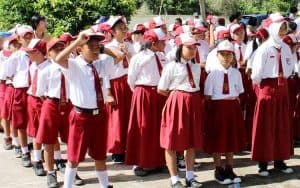 The primary school students must wear white shirts with short sleeves. The boys wear red shorts while the girls wear red plaited skirts that are just below the knees. Both boys and girls must wear red ties.
The primary school students must wear white shirts with short sleeves. The boys wear red shorts while the girls wear red plaited skirts that are just below the knees. Both boys and girls must wear red ties.
There is an exception to Muslim students who are girls. They are given the freedom to wear white shirts with long sleeves. Also, they are allowed to have long skirts up to their ankles. The girls are also allowed to wear scarfs to cover their head. This is allowed to all levels of school in Indonesia.
- Middle School Uniform
 The students in the middle school wear white shirts with short sleeves. The shorts that the boys must wear are navy blue. On the other hand the girls wear knee length skirts that are navy blue. The uniforms include wearing navy blue ties. The shoes that the Indonesian students usually wear for school is black with laces. Additionally, the socks are often required to cover the ankles.
The students in the middle school wear white shirts with short sleeves. The shorts that the boys must wear are navy blue. On the other hand the girls wear knee length skirts that are navy blue. The uniforms include wearing navy blue ties. The shoes that the Indonesian students usually wear for school is black with laces. Additionally, the socks are often required to cover the ankles.
Black belts are often a mandatory requirement too. Indonesian students must wear the school uniform neatly with respect. Any signs of breaking the rules may result in serious punishment.
- High School Uniform
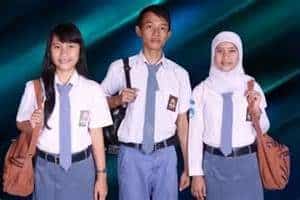 As for the uniform that high school students wear, the white shirts with short sleeves are also a must. In contrast to the previous levels of school, the boys wear trousers instead of shorts. However, the girls still wear knee length skirts. Both the trousers and skirts are greyish blue. They are also required to wear ties of the same colour.
As for the uniform that high school students wear, the white shirts with short sleeves are also a must. In contrast to the previous levels of school, the boys wear trousers instead of shorts. However, the girls still wear knee length skirts. Both the trousers and skirts are greyish blue. They are also required to wear ties of the same colour.
Other uniforms are also worn on different days of the week. There is a batik uniform that is usually worn on some days of the week. There is also a scout uniform worn on days specified by the schools. The scout uniform consists of wearing a light brown shirt with short sleeves. The shorts, trousers or skirts worn are dark brown. There is also a red and white scarf tied around the collar of the shirt.
School Traditions in Indonesia
Below are some school traditions and etiquette that all levels of students in Indonesia are encouraged to participate in.
1. School Flag Ceremony
 Monday marks the beginning of the school week. Each Monday morning, Indonesian students carry out the school flag ceremony. This is where both teachers and students line up in the school field.
Monday marks the beginning of the school week. Each Monday morning, Indonesian students carry out the school flag ceremony. This is where both teachers and students line up in the school field.
Usually there is a short speech delivered by the school principal but the most important part of the ceremony is raising the national flag. The national anthem is also sung and the 1945 Constitution is recited by everyone. The ceremony lasts for about an hour. The flag ceremony aims to build the students’ respect and nationalism for the country.
The students must wear complete uniform from head to toe. Students who are caught weare incomplete uniform are pulled out of the student lines. The students will be punished after the ceremony is finished.
Also read: Flag of Indonesia
2. Student and Teacher Relationship
In Indonesia, school teachers are often referred to as the parents at school. Therefore, the students must respect their teachers as much as they respect their parents at home. Indonesian students must call their teachers with formal titles of Pak (Mr.) and Bu (Mrs.). Calling them informally or through nicknames is seen as highly disrespectful. But some teachers don’t really mind it and may give exceptions.
Also read: Indonesian Etiquette
Since the students are taught to respect their teachers, they are also asked to obey and to listen without questioning. Questioning certain orders or words may be seen as rebellious and rude. Students may end up in trouble. However, there are teachers who are more open to any suggestions or critics offered by the students.
School Habits in Indonesia
The following are the usual routines that most students carry out daily, monthly and yearly. They involve what the students eat for lunch, what they study in school, how they get to school and the most anticipated school holidays.
1. School Lunch
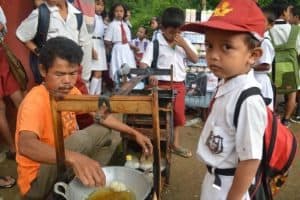 The school lunch of the Indonesian students is not restricted to cafeterias only. There are canteens that sell various forms of food to the students. However, students may also bring along a lunch box with them that is already prepared from home. Moreover, students may eat their lunch or snacks by buying food from the street vendors nearby the school.
The school lunch of the Indonesian students is not restricted to cafeterias only. There are canteens that sell various forms of food to the students. However, students may also bring along a lunch box with them that is already prepared from home. Moreover, students may eat their lunch or snacks by buying food from the street vendors nearby the school.
Most of the food vendors are right outside the gates of the school. The students buy food using allowance money given by their parents. During lunch breaks, the students are not allowed to leave the school area at all so they can’t eat lunch at home.
2. School Transportation
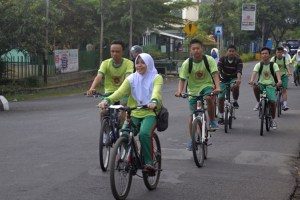 School bus is a rarity for Indonesian students. However, there are minibus that they can pay regularly to transport them between home and school. Indonesian students rely on private form of transportation when they go to school.
School bus is a rarity for Indonesian students. However, there are minibus that they can pay regularly to transport them between home and school. Indonesian students rely on private form of transportation when they go to school.
Also read: Public Transportation in Indonesia
Very young aged students are driven by their parents with cars. Some are taken to school with motorbikes, bicycles or other means of transport. Students who are older may ride their own cars or motorcycles. They may ride the bus or the minibus. Some students can even ride bicycles or simply walk to school.
3. National Exam for Indonesian Students
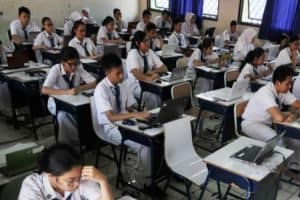 The National Exam is a standardised exams for every student in Indonesia who are in their last year of their elementary, middle and high school. The exam is compulsory since it will help them continue their education to higher level.
The National Exam is a standardised exams for every student in Indonesia who are in their last year of their elementary, middle and high school. The exam is compulsory since it will help them continue their education to higher level.
School subjects that are in the national exam include Science, English, Math and Indonesian. There are passing grades that students must achieve. The National Exam is usually paper-based. However, in the recent years, there are some changes. The Department of Education is beginning to implement computer-based National Exam.
The National Exam have received numerous amount of criticisms. It is seen as an inadequate measure of a student’s capability. It puts tremendous amount of pressure on Indonesian students and increase the chances of cheating.
4. School Week and Extracurriculars
The school week in Indonesia starts from Monday to Friday. It used to last until Saturday but recent regulation only requires 5 days of school. The hours may depend on the school rules but on average, school starts from 7 AM to 3 PM.
After school ends, extracurricular activities may begin right up to 5 PM or even later. Indonesian students are given a huge variety of activities that they can choose from. They may want to delve deeper into their passion or try something new. Extracurriculars may consist of basketball, photography, journalism, music, English club, soccer, traditional dance or chess. Students are highly encouraged to participate in one of these extracurriculars.
5. School Subjects and Language
Indonesian students study 15 subjects on average for each semester. These subjects include Arts, Humanities, Social Sciences, Natural Sciences, Languages, Literature and so on. A subject may be repeated once or twice each week.
The language used in classroom is Bahasa Indonesia, known as Indonesian Language. However, some schools in rural areas may use local language due to some limitation understanding of Bahasa Indonesia. Also, private schools may use a both English and Bahasa Indonesia while international schools use English entirely.
6. After School Tutoring
For Indonesian students, school life does not end once they leave it at the end of the day. After school, many students have tutors to help them with homework or to get ahead of the school subjects. Tutors could be private where the teachers come to the house of the students.
There are also tutoring institutions where students can go to. The setting would be similar to that of a classroom. There will be a small group of students inside the classroom with the tutor. Tutoring institutions are extremely packed and popular for students who are about to have their national exam.
Read more: Indonesian Education System
7. School Holiday
The beginning of the school year starts in the month of July and ends in June. Between those months, there are national holidays and school breaks which mean that school also closes. The school holidays include Christmas which is merged with the mid-term break in December. The school holiday begins in mid-December up to January.
Another one is two months school holiday during the Fasting month up until the end of Eid-al Fitr holiday. The dates and the months of the holiday depends on the Islamic calendar. There are other school holidays but they don’t last for months. These school holidays are Independence Day or major religious holy days which may last for a day or two.
Read more:
Despite the obstacles that Indonesian students may face in school, they always have a thirst for knowledge. The teachers and students work together so the students can have a bright future.
